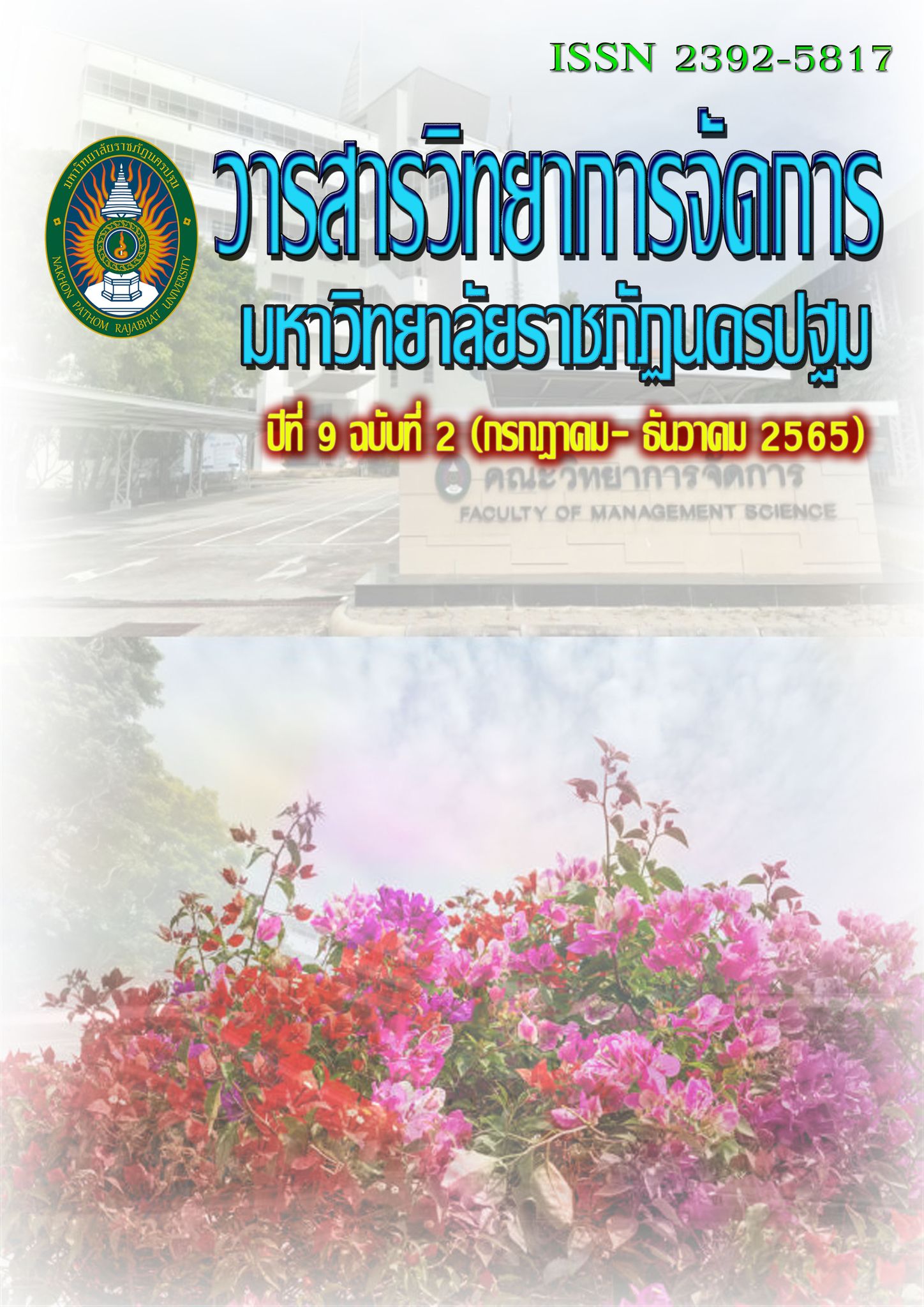Influence of service marketing mix to create a competitive advantage from Chinese tourists
Main Article Content
Abstract
Research objectives: (1) to survey the tourism behavior of Chinese tourists visiting Thailand. (2) To analyze the composition of the service marketing mix from the assessment of Chinese tourists. (3) To study the influence of the service mix model; service market to create a competitive advantage from Chinese tourists.
The researcher used quantitative research techniques. Data were collected from surveying 400 Chinese tourists who visited Thailand, by using a convenient sample selection method. The statistics used to analyze the data consisted of percentage, means and standard deviation, second order confirmatory factors analysis and multiple indicator multiple cause model were analyzed using a structural model/structural equation model to measure:
1) Tourism behavior of Chinese tourists traveling to Thailand. It was found that those who traveled to Thailand together with the majority of tourists were family and relatives. The main purpose of traveling to Thailand is leisure. The greatest tourist attraction for leisure is visiting beautiful and diverse tourist destinations in Thailand. Cost analysis per person. For a trip to Thailand, it is 5,001-10,000 Yuan. the majority of expenditures are for souvenir purchases and cosmetics. The average number of trips to Thailand is 3-4 times a year. The number of days per trip is an average stay of 3-5 days in Thailand. Most tourist travel over weekends.
The source of Thai tourism information was collected through social networks. Destination analysis for traveling in Thailand was majored to be a friend or relatives accommodation facilities.
2) Confirmative Component Analysis. It was found that the marketing mix that affects tourism according to the views of Chinese tourists consisted of price, distribution channels and marketing promotion respectively.
3) A service marketing mix influence model to create a competitive advantage from Chinese tourists, consisting of distribution channels (β=0.97), physical characteristics (β=0.65), marketing promotion (β=0.33), process (β=0.28), products (β=0.27), price (β=0.17). While the personnel factor will have a statistically insignificant effect (β=0.09). The equation has 94% predictive power.
Article history: Received 7 February 2022
Revised 28 March 2022
Accepted 1 April 2022
SIMILARITY INDEX = 2.82 %
Article Details

This work is licensed under a Creative Commons Attribution-NonCommercial-NoDerivatives 4.0 International License.
The views and opinions of the article appearing in this journal are those of the author. It is not considered a view and responsibility of the editorial staff.
References
กระทรวงการท่องเที่ยวและกีฬา. (2558). ยุทธศาสตร์ด้านการท่องเที่ยวของประเทศไทย พ.ศ. 2558 – 2560. [ออนไลน์]. ค้นเมื่อ 25 มกราคม 2564. จาก http://www.mots.go.th/ewt_dl_link.php?nid=7114
คุณากร เหวิน. (2556). กฎหมายการท่องเที่ยวใหม่จีนกระทบราคาทัวร์พุ่ง ทัวร์สิงคโปร์-มาเลเซีย-ไทย กว่า 10,000 หยวน. [ออนไลน์]. ค้นเมื่อ 25 มกราคม 2564. จาก http://www.thaibizchina.com/thaibizchina/th/china-economic-business/result.php?SECTION_ID=497&ID=13183
ฉัตยาพร เสมอใจ. (2550). พฤติกรรมผู้บริโภค. กรุงเทพฯ: ซีเอ็ดยูเคชั่น จำกัด (มหาชน).
แนวหน้า.(2563). เอกชนชี้ท่องเที่ยวเริ่มฟื้นตัว จีนอยากมาไทยมากสุดหลังโควิดจบ. [ออนไลน์]. ค้นเมื่อ
มกราคม 2564. จากhttps://www.naewna.com/business/532042
เลิศพร ภาระสกุล. (2558). แรงจูงใจและทัศนคติที่ส่งผลต่อความพึงพอใจโดยรวมของนักท่องเที่ยว ชาวจีนต่อการท่องเที่ยวประเทศไทย. [ออนไลน์]. ค้นเมื่อ 25 มกราคม 2564. จาก http://www.dpu.ac.th/dpurc/ assets/ uploads/public/bosn62ukr74skks0gk.pdf
ศิวารัตน์ ณ ปทุม และคณะ.(2550). พฤติกรรมผู้บริโภคชั้นสูง. กรุงเทพฯ: โอเชี่ยน บุค มาร์ท.
สุภรณ์ อัตถาวงศ์ เกรียงไกร โพธิ์มณี ขวัญมิ่ง คําประเสริฐ และ สุภาภรณ์ พรหมฤาษี. (2564). ยุทธศาสตร์
การพัฒนาธุรกิจท่องเที่ยวทางแม่น้ำเจ้าพระยาสำหรับนักท่องเที่ยวชาวจีนในเขตกรุงเทพมหานคร.
วารสารสังคมศาสตร์และมานุษยวิทยาเชิงพุทธ. 6(2). 361-374.
อัครพงศ์ อั้นทอง และ มิ่งสรรพ์ ขาวสอาด. (2554). ภาพลักษณ์และประสบการณ์ของนักท่องเที่ยวต่างชาติใน
ตลาดที่สำคัญของประเทศไทย. วิทยาการวิจัยและวิทยาการปัญญา. 9(1). 27-41.
อารีวรรณ บัวเผื่อน และ สุดาพร กุณฑลบุตร. (2562). ปัจจัยส่วนประสมทางการตลาดที่มีผลต่อการตัดสินใจ
ของนักท่องเที่ยวชาวจีนในการมาท่องเที่ยวประเทศไทยกรณีศึกษา สถานที่ท่องเที่ยวในจังหวัดชลบุรี.
Journal of Management and Development Ubon Ratchathani Rajabhat University.
(2). 199-223.
Besanko, D., Dranove, D., Shanley, M. and Schaefer, S. (2004). The Economics of Strategy. (3rd ed.). USA: John Wiley and Sons, Inc.
Ciriković, E. (2014). Marketing Mix in Tourism. Academic Journal of Interdisciplinary Studies, 3(2), 111. Retrieved January 20, 2022. from https http://www.richtmann.org/journal/index.php/ajis/article/view/2955
Cronbach, L. J. (1974). Essentials of psychological testing. (3rd ed). New York: Harper & Row.
David, F. R. and David, F. R. (2015). Strategic Management: A Competitive Advantage Approach, Concepts and Cases. (15th ed.). Boston: Pearson Education.
Gronroos, C. (1978), A Service‐Orientated Approach to Marketing of Services. European Journal of Marketing, 12 (8). 588-601.
Hair, J. F., Black, W. C., Babin, B. J. & Anderson,R. E. (2010). Multivariate Data Analysis.
(7th ed.). Upper Saddle River, NJ: Prentice Hall.
Heizer, J. and Render, B. (2014). Operation Management: Sustainability and Supply Chain Management. (11th ed.). Boston: Pearson Education.
Holloway, J. C. (2012). The Business of Tourism. (9th ed.) Pearson Education Canada
Kar, S. B. (2011). Communications and marketing in health and family planning programs.
Marketing and Preventive Health Care: Interdisciplinary and Interorganizational
Perspectives, 28. 674 - 690
Kotler: and Armstrong, G. (2010). Principles of Marketing. (13 th. ed.). Pearson.
Kotler. (1997). Marketing Management: Analysis, Planning, Implementation and Control. (9th ed). New Jersey: A Simon & Schuster Company.
Mellow yellow. (2558). นักท่องเที่ยวชาวจีน ศักยภาพที่ไทยต้องจับตามอง. [ออนไลน์]. ค้นเมื่อ 25 มกราคม 2564. จาก https://www.marketingoops.com/reports/high-value-chinese-tourist/
Peijun Han. (2563). แนวทางการพัฒนาความภักดีด้านการท่องเที่ยวของนักท่องเที่ยวจีนในประเทศไทย.
วารสารวิทยาการจัดการ มหาวิทยาลัยราชภัฏนครปฐม, 7(1). 92-106.
Saloner, G., Shepard, A. and Padolny, J. (2001). Strategic Management. New York: John Wiley and Sons.
Thaipublica. (2559). The China Wave คลื่นจีนบุกไทย. [ออนไลน์]. ค้นเมื่อ 25 มกราคม 2564. จาก http://thaipublica.org/2016/04/the-china-wave-1/
Weaver D. and Oppermann M., (2000). Tourism management. Brisbane [etc.]: John Wiley & Sons.


